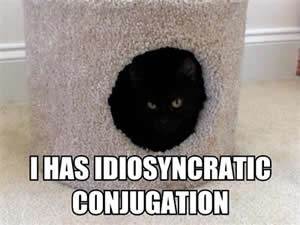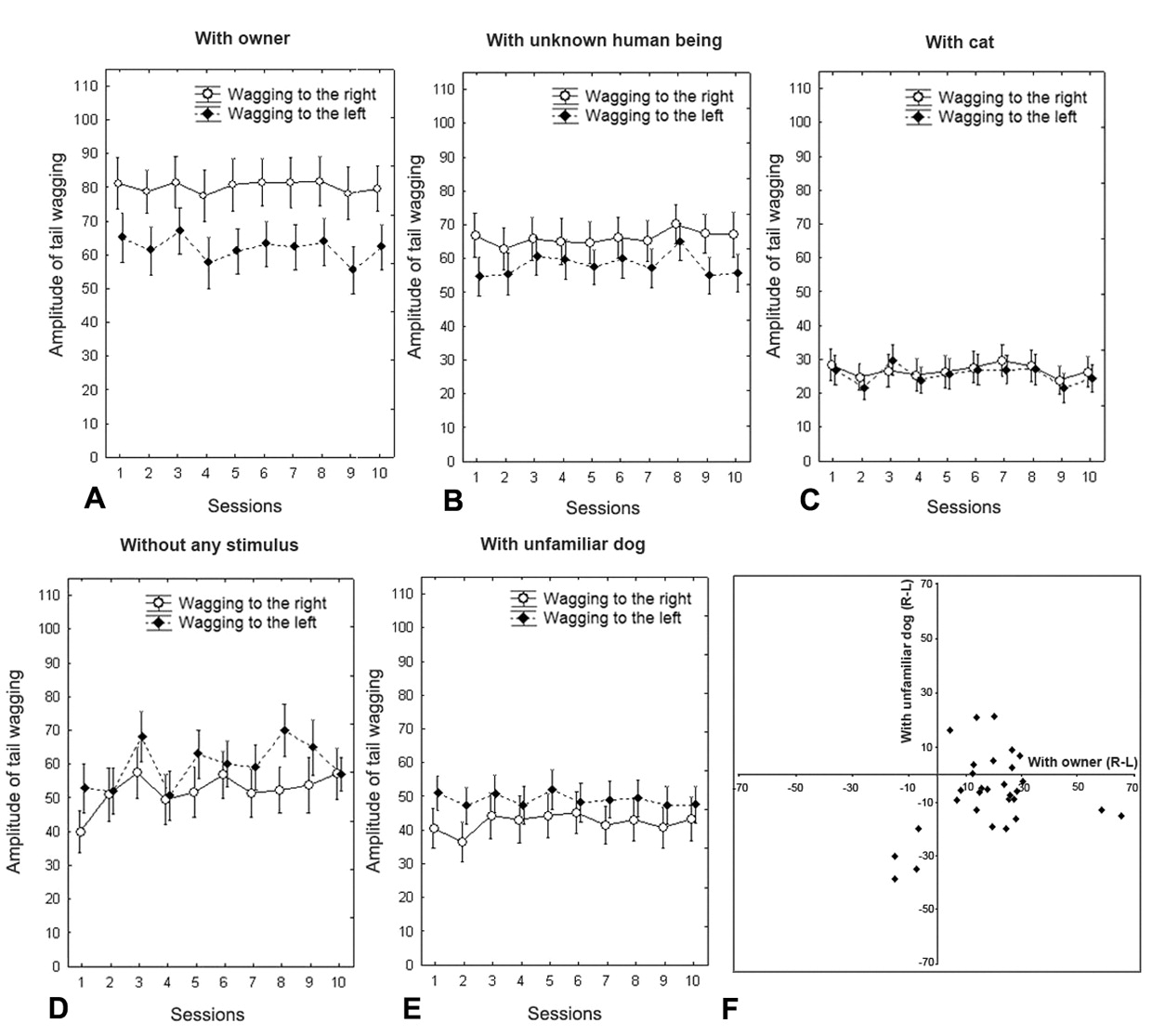April 25, 2007
Kitty Pidgin and asymmetrical tail-wags
 Anil Dash has a fun post arguing that "Cats Can Has Grammar" (4/23/2007). Surveying lolcats and related phenomena, he quickly passes over the snowclone "I'm in UR X Ying your Z" and the whole Invisible X phenomenon, and focuses on "the newly dominant lolcats, of the family 'I Can Has Cheezeburger?'". He observes that
Anil Dash has a fun post arguing that "Cats Can Has Grammar" (4/23/2007). Surveying lolcats and related phenomena, he quickly passes over the snowclone "I'm in UR X Ying your Z" and the whole Invisible X phenomenon, and focuses on "the newly dominant lolcats, of the family 'I Can Has Cheezeburger?'". He observes that
The rise of these new subspecies of lolcats are particularly interesting to me because "I can has cheezeburger?" has a fairly consistent grammar. I wasn't sure this was true until I realized that it's possible to get cat-speak wrong.
Incorrect kitty pidgin jumped to my attention the first time I saw a reference to Dune being used with a lolcat image. The caption on the linked version of the image, "The spice must flow." is fine, if not particularly cat-like. But the caption on the version I saw first was much more verbose: "I are dunecat. I controls the spice, I controls the universe." Besides being an awkward attempt at overexplaining the punchline (I've never read Dune or seen the film, but the joke is obvious) this was just all wrong. The fact that we can tell no cat would talk like this shows that kitty pidgin is actually quite consistent
I feel really out of it, having no experience with lolcat and no intuitions about its captional norms. After a bit of investigation, though, I've decided that I don't feel badly enough about this to undergo the lolcat immersion required to change it.
Anil continues:
... I suggested this consistent grammar for lolcats could be a "cweeole". Knowing a bit more about such things now, I realize this isn't a creole but more likely a pidgin language, used to help cats talk to humans. And since "pidgin" is already a cutesy spelling of a mispronunciation, there doesn't seem to be any really cute way to rename it to reflect its uniqueness. "Kitty pidgin" might be the closest thing we have to a name for this new language.
Isn't this more like kitty baby-talk, long used for cutesy interactions with cats and small dogs, most memorably by certain P.G. Wodehouse characters? This 1922 passage illustrates the same type of "idiosyncratic conjugation" that Anil has identified in lolcats (of course minus the 4chan and l33t-speak overlays):
Vincent Jopp flushed darkly. Even the strongest and most silent of us have our weaknesses, and my employer's was the rooted idea that he looked well in knickerbockers. It was not my place to try to dissuade him, but there was no doubt that they did not suit him. Nature, in bestowing upon him a massive head and a jutting chin, had forgotten to finish him off at the other end. Vincent Jopp's legs were skinny.
"You poor dear man!" went on Mrs. Jane Jukes Jopp. "What practical joker ever lured you into appearing in public in knickerbockers?"
"I don't object to the knickerbockers," said Mrs. Agnes Parsons Jopp, "but when he foolishly comes out in quite a strong east wind without his liver-pad----"
"Little Tinky-Ting don't need no liver-pad, he don't," said Mrs. Luella Mainprice Jopp, addressing the animal in her arms, "because he was his muzzer's pet, he was."
I was standing quite near to Vincent Jopp, and at this moment I saw a bead of perspiration spring out on his forehead, and into his steely eyes there came a positively hunted look. I could understand and sympathize. Napoleon himself would have wilted if he had found himself in the midst of a trio of females, one talking baby-talk, another fussing about his health, and the third making derogatory observations on his lower limbs. Vincent Jopp was becoming unstrung.
Meanwhile, over at the New York Times, Sandra Blakeslee reports on some research on the interpretability of tail wagging in dogs: "If You Want to Know if Spot Loves You, It's in His Tail", 4/24/2007. The message is not the old news that tail-wagging expresses feelings, or that more vigorous wagging expresses stronger feelings, but the new information that the feelings' nature determines which side of the dog gets more of the wag. This has been discovered by a team of Italian veterinarians, and reported in Giorgio Vallortigara et al., "Asymmetric tail-wagging responses by dogs to different emotive stimuli", Current Biology, 17(6), 20 March 2007, pp R199-R201. They found
... some unexpected and striking asymmetries in the control of tail movements by dogs: differential amplitudes of tail wagging to the left or to the right side associated with the type of visual stimulus the animals were looking at.
Here's a graphical summary of their results:

And their interpretation goes like this:
Davidson [3] suggested that the anterior regions of the left and right hemispheres are specialised for approach and withdrawal processes, respectively. Although Davidson's hypothesis was developed in the context of human neuropsychology, approach and withdrawal are fundamental motivational dimensions which may be found at any level of phylogeny [4].
In our experiment, stimuli that could be expected to elicit approach tendencies, such as seeing a dog's owner, were associated with higher amplitude of tail wagging movements to the right side (left brain activation) and stimuli that could be expected to elicit withdrawal tendencies, such as seeing a dominant unfamiliar dog, were associated with higher amplitude of tail wagging movements to the left side (right brain activation). (As to the cross-over of descending motor pathways, in dogs the rubrospinal tract is the predominantly volitional pathway from the brain to the spinal cord; the pathway decussates just caudal on the red nucleus and descends in the controlateral lateral funiculus; fibres of the rubrospinal tract terminate on interneurons at all levels of the spinal cord; see [5].)
Reference [3] is R.J. Davidson, Well-being and affective style: neural substrates and biobehavioural correlates, Phil. Trans. R. Soc. Lond. B 359 (2004), pp. 1395–1411.
So if you really want to know what your dogs are feeling, anyhow on the approach/avoidance dimension, watch what side they wag on. Translation into babytalk is strictly optional, as far as I'm concerned. What I want to know it, do dogs themselves pay attention to this potentially-informative aspect of their fellows' signaling?
And, of course, how about cats' tail-lashing?
[Nancy Wright writes:
Yesterday, one of the regular inmates over at www.icanhascheezburger.com was posting a tutorial on how to speak it: "LOL-Kitteh as a Second Language".
Actually, now that I think of it, that may have been the investigation you did that made you decide you didn't want "to undergo the lolcat immersion required to change [your lack of experience]."
It was one of the steps on the path, certainly. Though I suspect the author may be the Pedro Carolino of the ICHC idiom.]
More Language Log posts on lolcats:
"Kitty Pidgin and asymmetrical tail-wags", 4/25/2007
"Lolbrarians", 5/5/2007
"L337 KATZ0RZ", 5/12/2007
"Linguist macros?", 5/18/2007
"Lol-lexicography", 5/18/2007
"Lol Vincit Omnia", 5/27/2007
"Loop until kthxbye", 5/30/2007
"Accelerando molto con micino", 5/31/2007
"Amplifying 'faint signals' from the alpha geeks who are creating the future", 6/2/2007
"Lolxicographers", 6/7/2007
]
Posted by Mark Liberman at April 25, 2007 09:46 AM